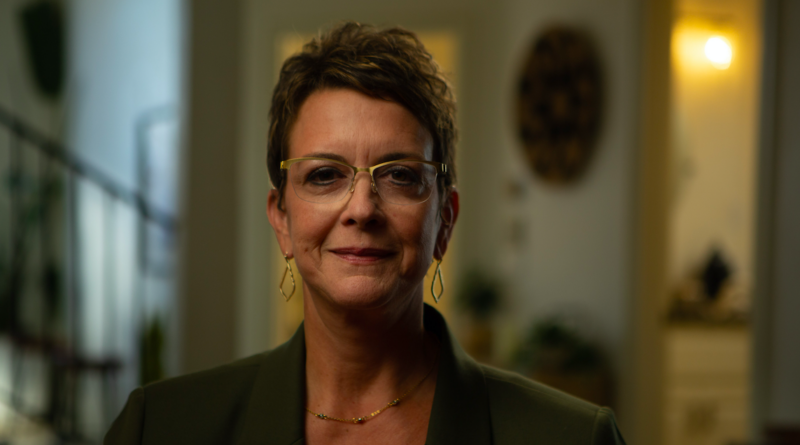INTERVIEW: Amy Downs on how she survived the Oklahoma City bombing
Photo: Amy Downs, a survivor of the Oklahoma City bombing, is featured in the new three-part documentary series Oklahoma City Bombing: One Day in America, premiering April 2. Photo courtesy of National Geographic / Brandon Widener / Provided by press site with permission.
Thirty years ago this month, a city came under attack, and a nation faced the deadly realities of domestic terrorism. On April 19, 1995, the Alfred P. Murrah Federal Building in Oklahoma City was bombed, killing 168 people, including 19 children. Hundreds more were injured in the attack, which was carried out by a man who was an ex-Army soldier and security guard, according to the FBI’s official recounting of the event. The incident was the deadliest act of domestic terrorism in American history.
Amy Downs was in that federal building on that fateful day. She was working for the credit union on the third floor when the bomb went off, and she was catapulted into a multi-hour saga of being buried by rubble and awaiting first responders to find her beneath the collapsed building.
Downs’ story is part of the new National Geographic three-part documentary series, Oklahoma City Bombing: One Day in America, which premieres Wednesday, April 2, at 8 p.m. on the TV network. It will also be available to stream on Disney+ and Hulu.
“I think that it is a powerful message of hope, the human spirit and how we came together in the face of evil,” Downs said about the lessons to be learned from that day. “Our differences are important and are good, but not taking that to the extreme. Don’t let that move into hatred. Don’t let that move into something that can destroy humanity.”
Downs said the documentary series is a solid historical account of what happened in April 1995, and it can help inform today’s TV viewers, some of whom may have not been born in 1995. In addition to Downs, audiences will hear from local Oklahoma City reporter Robin Marsh, FBI special agent Bob Ricks and Frank Keating, former governor of Oklahoma.
“It was a beautiful morning,” Downs remembered of that day. “Red buds were in bloom, a gorgeous spring morning. I was getting ready to go to work for the financial institution, the credit union on the third floor, and it was just a normal day. I was chatting with all my friends that morning, having no idea that something like that was getting ready to occur.”
Oklahoma City, Downs said, is an amazing place, known for its generous people. The workers in the downtown area were carrying on with their business as if April 19 was going to be a normal day, but then the explosion happened. When the bomb went off, she had no means of communicating with the outside world, to let family and friends know where she was located.
“Back then if you had a cellphone, you had a briefcase; it was huge,” she said. “The technology was not what it is. You had to wait for the newspaper to come out every day to figure out who was among the dead, what was going on. It definitely was very different, and, yes, it was much chaos at first, as you would imagine, just trying to figure out what to do and how to move forward. I don’t think there was a disaster preparedness plan that could possibly cover exactly what occurred.”
Downs said she still deals with post-traumatic stress disorder (PTSD), and little things can trigger her. She lives near a military base now, and she’s aware of the sounds that come from the nearby vehicles and aircraft.
“I’m so thankful for counseling,” she said. “I’m so glad that we’re normalizing that for people. It used to be sort of a shame thing. You only went to counseling if there was something wrong with you, and now we realize, no, it’s very important to take care of our mental health. So through counseling, I’ve been able to learn how to deal with PTSD, know what the triggers are, just know that it’s normal for what I have been through.”
After the bomb went off, the story was only just beginning for Downs. Physically she could not move. It was dark, and she couldn’t see anything in front her. She attempted to open her eyes, but she honestly couldn’t tell if they were open or closed.
“It was just pitch black and hot,” Downs said. “At first there was a lot of screaming, but then that stopped. I honestly did not know where I was. I found out later that I was still in my chair, and I had fallen three floors and was buried under 10 feet of rubble. I had about 45 minutes laying there wondering what happened before I heard men’s voices that were looking for the daycare babies, and I could begin screaming and yelling for help.”
She remained under the rubble for approximately six-and-a-half hours. She can account for the entire time span because she didn’t fall unconscious, even though she may have hit her head. She still remembers the conversations she had with her rescuers.
“I find that all of us at some point in our lives become buried in the rubble, me literally, but other people it may be a job loss, a marriage ending, something medical,” Downs said. “We all have times where our world just crashes around us, and so I think encouraging one another with the stories of how we get through these tough times is important to help one another.”
By John Soltes / Publisher / John@HollywoodSoapbox.com
Oklahoma City Bombing: One Day in America, featuring Amy Downs, premieres Wednesday, April 2, at 8 p.m. on National Geographic, with streaming available on Disney+ and Hulu. Click here for more information.

